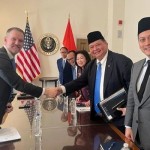Total number of posts 460.
ASEAN is stepping up efforts to deepen regional economic integration and revitalize intra-regional trade amid increasing volatility in the global trading environment. According to statistics, trade among ASEAN member states currently accounts for only around 20–22% of the bloc’s total trade value, a modest figure compared to the potential of a region with nearly 700 million consumers.
Speaking at the 57th ASEAN Economic Ministers’ (AEM) Meeting, Malaysia’s Minister of Investment, Trade and Industry, Tengku Datuk Seri Zafrul Abdul Aziz – Chairman of the 2025 AEM underscored that promoting intra-ASEAN trade is not only a development goal but also a strategic imperative to strengthen self-reliance, build resilience, and enhance ASEAN’s global competitiveness.
In 2024, intra-ASEAN trade accounted for about 21.2% of the bloc’s total trade, far below the European Union (EU), where internal trade makes up around 60%. This has prompted ASEAN to continue implementing trade facilitation measures, removing barriers, and boosting connectivity among member economies.
A notable highlight lies in the progress of digital trade facilitation. The report “Digital and sustainable trade facilitation in ASEAN 2023” shows that ASEAN’s implementation rate reached about 81%, higher than the Asia–Pacific average of roughly 67%. Full cross-border electronic document exchange and paperless trade systems are expected to reduce trade costs by more than 9%.
However, non-tariff barriers remain a major challenge to regional integration. Export restrictions, domestic preference policies, and regulatory differences among member states continue to hinder trade flows. In Malaysia, the Bumiputera policy which aims to promote economic participation and access to public procurement for the indigenous Malay population and other native groups is seen as an example that may, in some cases, pose certain constraints on foreign trade and investment.
To overcome these challenges, ASEAN has been encouraged to accelerate the implementation of initiatives such as the ASEAN Single Window, paperless trade systems, and enhanced digital cooperation. Strengthening physical, digital, and regulatory connectivity across member states is viewed as a key driver for improving intra-regional trade efficiency and fostering a more resilient and deeply integrated ASEAN.
Source: Compiled by the Multilateral Trade Policy Department, Ministry of Industry and Trade of Viet Nam














